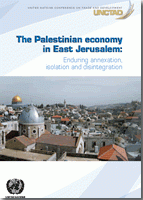
International organizations and Israeli and Palestinian non-governmental organizations have published reports and studies in recent years on East Jerusalem focused mainly on political and social conditions. But few have examined its economy, which is generally considered to follow the overall trend of the West Bank economy and is represented statistically as part of it. Be that as it may, East Jerusalem’s economy, like other features of its society, culture and landscape, is also shaped by factors unique to its particular experience in the face of Israeli occupation and settlement.
This report aims to explore these hitherto neglected issues within the context of the secretariat’s continuing assessment of the economic development prospects of the occupied Palestinian territory and obstacles to trade and development, and with a view to alleviating the adverse economic and social conditions imposed on the Palestinian people, as called for by the Doha Mandate. Needless to say, any study and understanding of the socioeconomic conditions of East Jerusalem is not only complicated by the complex legal, administrative and political dimensions of the issue, but equally by the statistical gap into which East Jerusalem falls, sparsely covered in Israeli statistics and administratively categorized by Palestinian statistics within a different geographical context.
The preparation of this report confronted major difficulties in obtaining consistent time series or other data for East Jerusalem, which in turn limited the empirical basis for the in-depth economic structural analysis that the city’s unique situation calls for.
The report analyses data available from various sources, chief among them the Palestinian Central Bureau of Statistics (PCBS). The report offers an economic perspective of the city by exploring its growth record during the last two decades, tracing the evolution of its economic structure – the share of the various economic sectors in output and employment – and identifying some of the reasons behind the weak investment record and some of the obstacles to overall development.
The first section of this report reflects on the historical and political context of East Jerusalem, including the present difficulties faced by Palestinian Jerusalemites, as well as the status of the city under international law.
The second section examines the structure and evolution of the economy of East Jerusalem over time: the main economic sectors and their contribution to output and employment, some of the challenges these sectors face and their relative weight over time. It also highlights obstacles to access to capital and constraints on investment.
The third section looks at the structure and characteristics of East Jerusalem’s labour force as well as the reversal of the city’s role as a magnet for Palestinian job seekers from the rest of the West Bank, to a labour exporter to Palestinian and Israeli job markets. The section also documents the acute problems of poverty and living standards, which are inextricably linked to the difficult labour market conditions facing Palestinian in East Jerusalem. It highlights furthermore the complex state of health and education services for Palestinians in East Jerusalem, and the limited and unequal access to these services. A special focus on the Old City of Jerusalem concludes this review of key social issues.
The concluding section identifies main areas for possible targeted policy interventions to revive East Jerusalem so that it can resume its historical role as the centre of Palestinian economic and cultural life.


